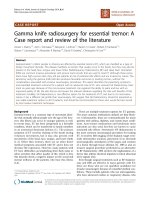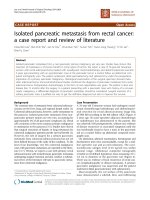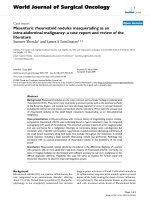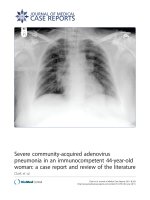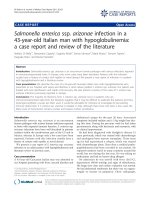Báo cáo y học: " Myocardial infarction with normal coronary arteries: a case report and review of the literature" pps
Bạn đang xem bản rút gọn của tài liệu. Xem và tải ngay bản đầy đủ của tài liệu tại đây (382.33 KB, 5 trang )
BioMed Central
Page 1 of 5
(page number not for citation purposes)
Journal of Medical Case Reports
Open Access
Case report
Myocardial infarction with normal coronary arteries: a case report
and review of the literature
Luigi Iuliano*
1
, Fausta Micheletta
1
, Alessandro Napoli
2
and Carlo Catalano
2
Address:
1
Department of Internal Medicine, Unit of Vascular Medicine, Sapienza University of Rome, Corso della Repubblica, 04100 Latina, Rome,
Italy and
2
Department of Radiological Sciences, Sapienza University of Rome, via del Policlinico 155. 00161 Rome, Italy
Email: Luigi Iuliano* - ; Fausta Micheletta - ;
Alessandro Napoli - ; Carlo Catalano -
* Corresponding author
Abstract
Introduction: Although acute myocardial infarction is generally associated with obstructive
coronary artery disease, myocardial infarction associated with normal coronary arteries is a well-
known condition. The overall prevalence rate of myocardial infarction with normal coronary
arteries is considered to be low, varying from 1% to12% depending on the definition of "normal"
coronary arteries.
Case presentation: We describe here a case of a 49-year-old woman with a history of prior
myocardial infarction who continued to be asymptomatic after a 10-year follow-up, in the absence
of a high-risk profile for adverse outcomes. She was studied with multi-slice coronary computed
tomography and whole-body angiography, which showed normal coronary and extra-coronary
arteries.
Conclusion: This case report raises two important issues. First, the possible role of multi-slice
computed tomography/coronary angiography in the risk- and prognosis assessment of patients with
known or suspected coronary artery disease. Second, the important role played by long-term
pharmacological therapy in patients with prior myocardial infarction and normal coronary arteries.
Introduction
Myocardial infarction (MI) with normal coronary arteries
is a medical condition, which has been described in the
literature for more than 30 years but is still a challenge in
medical practice because of the lack of evidence-based
medical data on its prognosis and on secondary preven-
tion. The prevalence of MI with normal coronary arteries
has always been considered low, varying between 1% and
12%. However, it actually involves a considerable number
of patients, calling for more clinical trials which specifi-
cally study this sub-population of patients affected by cor-
onary heart disease (CHD) [1-3].
We report a case of a young female patient with a previous
clinically diagnosed MI, who was asymptomatic in stand-
ard care therapy for a 10-year follow-up and has been
shown to have normal coronary arteries by coronary
multi-slice computed tomography (MSCT) and whole-
body angiography.
Case presentation
A 49-year-old woman was referred to our department for
a cardiological follow-up visit. She had a medical history
of hypertension and previous MI, with no history of dia-
betes mellitus, hypercholesterolemia or premature coro-
Published: 23 January 2009
Journal of Medical Case Reports 2009, 3:24 doi:10.1186/1752-1947-3-24
Received: 11 October 2008
Accepted: 23 January 2009
This article is available from: />© 2009 Iuliano et al; licensee BioMed Central Ltd.
This is an Open Access article distributed under the terms of the Creative Commons Attribution License ( />),
which permits unrestricted use, distribution, and reproduction in any medium, provided the original work is properly cited.
Journal of Medical Case Reports 2009, 3:24 />Page 2 of 5
(page number not for citation purposes)
nary artery disease in her family. She did not smoke, take
recreational drugs and was not on oestrogen replacement
therapy.
Ten years earlier, she had an inferior MI treated with sys-
temic thrombolysis, unfractioned heparin, aspirin, aten-
olol and intravenous nitroglycerine. During her
hospitalization, the echocardiogram (ECG) revealed aki-
nesis of the posterior-basal wall with an estimated ejec-
tion fraction of 50%. Laboratory tests including serum
glucose, lipids, blood count, liver-, kidney- and thyroid-
function tests were within normal limits. The day before
her discharge, she had a stress ECG negative for inducible
ischemia. The patient was discharged on the sixth day
with a drug regimen of aspirin, atenolol, captopril, simv-
astatin and isosorbide dinitrate.
After the MI and prior to the visit to our department, the
patient had been free from chest pain and dyspnea and
had a normal exercise tolerance. She had periodical ECGs
that showed the presence of akinesis of the posterior-basal
wall with a mildly depressed systolic function. She
reported a good control of arterial blood pressure with the
ongoing therapy, including perindopril 5 mg/day, hydro-
clhorotyazide 25 mg/day and atenolol 25 mg/day associ-
ated with aspirin and simvastatin 20 mg/day.
A physical examination showed blood pressure of 135/80
mmHg, heart rate of 64 bpm, BMI of 27 kg/m2, waist cir-
cumference of 85 cm and no findings of congestive heart
failure. The resting ECG showed a sinus rhythm at 62 bpm
and the presence of Q waves in II, III and aVF leads with
no other abnormalities.
Laboratory tests revealed a total serum cholesterol of 160
mg/dl, HDL cholesterol of 55 mg/dl, triglycerides of 78
mg/dl, LDL cholesterol of 89.6 mg/dl and fasting glycemia
of 116 mg/dl, with a normal OGTT and normal plasma
homocysteine.
On the basis of her medical records concerning the MI, we
confirmed the diagnosis of coronary artery disease (CAD)
according to the recently published universal definition of
MI [4].
For risk stratification, we studied the patient with non-
invasive diagnostic tests, including echocardiography and
a treadmill exercise test.
The ECG confirmed the presence of akinesis of the poste-
rior-basal wall with a mildly depressed systolic function
(LVEF 48%) and the treadmill exercise test showed no
signs of inducible ischemia.
Without any symptoms which suggest cardiac ischemia,
the results from the non-invasive tests suggested no high-
risk criteria for adverse outcomes for our patient. Accord-
ing to the guidelines by the American Heart Association/
American College of Cardiology (AHA/ACC), there was
thus no indication for conventional coronary angiogra-
phy.
Consequently, we decided to study her coronary arteries
non-invasively. MSCT angiography was performed using a
64-slice computed tomography (CT) scanner (Sensation
Cardiac 64; Siemens; Forchheim, Germany). The protocol
included a post-coronary phase for whole-body angiogra-
phy.
The MSCT angiographic analysis showed no coronary
lesions (Figure 1), but the presence of a hypodense area
involving more than 50% of the myocardial wall of the
left ventricular inferior basal portion (Figure 2). No
lesions were detected in the wholly explored extra-coro-
nary arterial system (not shown).
The patient was sent to follow-up with a drug regimen of
perindopril 5 mg/day and hydrochlorothiazide 25 mg/
day. Aspirin, atenolol and simvastatin were discontinued.
She was advised to lose weight and implement some life-
style changes and was asked to repeat laboratory tests for
a lipid profile before the next follow-up visit.
At the 6- and 12-month follow-up, the patient was free
from chest pain, LDL-cholesterol was below 140 mg/dl
without statin therapy and blood pressure was stable
below 140/90 mmHg.
Discussion
The overall prevalence rate of MI with normal coronary
arteries is considered to be low, varying from 1% to 12%,
depending on the definition of "normal" coronary arter-
ies, which usually includes no luminal irregularities (strict
definition) or arteries with some degree of stenosis (in
most cases, less than 30% stenosis) [1-3]. The incidence
seems to be strongly related to age and sex, with higher
rates in young and female patients [5]. Thus, studies of
women less then 45 years old, who have suffered acute
MI, have showed normal coronary arteries angiographi-
cally in 7% to 32% of cases [1,5,6]. We have described a
case of a young female patient with a history of prior MI
who, after a 10-year follow-up, continued to be asympto-
matic with no high-risk profile for adverse outcomes. She
was studied by MSCT angiography, which showed normal
coronary arteries.
This case report raises two important issues. First, the pos-
sible role of MSCT coronary angiography in risk- and
prognosis assessment of patients with known or suspected
Journal of Medical Case Reports 2009, 3:24 />Page 3 of 5
(page number not for citation purposes)
CAD. Second, the role of long-term pharmacological ther-
apy in patients with prior MI and normal coronary arter-
ies.
MSCT provides high-resolution coronary angiograms
non-invasively and has been demonstrated to be highly
accurate in ruling out coronary atherosclerosis [7]. Its high
negative predictive value for exclusion of significant coro-
nary artery stenosis, approaching 100%, makes it an
attractive method for the assessment of patients with
known or suspected CAD and no high-risk profile for
adverse outcomes; patients for whom conventional coro-
nary angiography is not indicated according to current
international guidelines. In particular, it might have an
important application in patients for whom a CAD diag-
nosis was made on a clinical basis with no angiographic
documentation.
We approached our patient according to a diagnostic algo-
rithm based on the current AHA/ACC guidelines. Our
patient had been asymptomatic since the MI event and
had had no high-risk features for adverse outcomes in rou-
tine non-invasive tests. Medical history, clinical features
and non-invasive tests did not provide specific diagnosis
and prognosis, which allowed us only to continue the cur-
rent medical therapy. According to the scheme provided
by the current guidelines, we should have considered fur-
ther imaging studies. However, in our patient, routine
non-invasive imaging studies, such as nuclear stress test-
ing or stress echocardiography would not have provided
any new information for a better risk- and prognosis strat-
ification. We considered the low age and the low cardio-
vascular risk profile of the patient at the time of acute MI,
the absence of symptoms after the event and the absence
of inducible ischaemia during the treadmill exercise test
and decided that a non-invasive delineation of the pres-
Coronary computed tomography angiography shows absence of flow limiting stenosis in both left (1a) and right (1b) coronary circulationFigure 1
Coronary computed tomography angiography shows absence of flow limiting stenosis in both left (1a) and
right (1b) coronary circulation. A tri-dimensional data set was reformatted using the maximum intensity projection tech-
nique. In Figure 1a, the image was taken along the anterior interventricular plane, allowing fine analysis of the left main as well
as the left anterior descending coronary artery. A maximum intensity projection view also allows partial assessment of the ori-
gin of the right coronary artery and the first diagonal branch. Figure 1b: an image acquired along the right atrio-ventricular
groove; the maximum intensity projection image clearly depicts the right circumflex artery up to the inferior portion.
a)
b)
Multiplanar reformatted images generated along the conven-tional short cardiac axis, showing focal areas of myocardial wall thinning associated with hypodensity (arrows), sugges-tive for non-recent myocardial wall infarctionFigure 2
Multiplanar reformatted images generated along the
conventional short cardiac axis, showing focal areas
of myocardial wall thinning associated with hypoden-
sity (arrows), suggestive for non-recent myocardial
wall infarction.
Journal of Medical Case Reports 2009, 3:24 />Page 4 of 5
(page number not for citation purposes)
ence and severity of coronary atherosclerosis would allow
insights for the further management of our patient.
MSCT angiography showed absolutely normal coronary
arteries. The absence of atherosclerosis lesions in this
patient was further confirmed in the extra-coronary arte-
rial tree, thus providing a definitive diagnosis. The high
negative predictive value of MSCT coronary angiography
allowed us to definitely exclude CAD and the need for fur-
ther diagnostic tests. Moreover, MSCT provided a more
accurate prognosis for our patient for two main reasons.
First, long-term prognosis in patients with MI and normal
coronary arteries is much better compared to patients with
coronary occlusive disease, especially in young and female
patients [2,5,8]. Patients with normal coronary arteries
have a good survival rate, around 90% at 3–7 years of fol-
low-up in different studies, and a significant lower rate of
reinfarction than patients with obstructive coronary dis-
ease [2,5,8]. Second, it has been recently demonstrated
that MSCT provides independent prognostic information
on baseline clinical risk factors in patients with known or
suspected CAD, showing an excellent prognosis in
patients with normal coronary arteries [9].
The diagnosis of prior MI with normal coronary arteries
raises a second important issue concerning the applica-
tion of AHA/ACC secondary prevention guidelines for
CHD. According to these guidelines, patients who have
had MI should receive indefinitely a drug regimen includ-
ing an antiplatelet agent, a beta-blocker, a statin with an
LDL-C goal of < 100 mg/dl or < 70 mg/dl, and an ace-
inhibitor with a blood pressure goal < 140/90 mmHg
[10]. As stated in the paper, cases covered by these guide-
lines include patients with established coronary and other
atherosclerotic vascular disease. Thus, cases with prior MI
and normal coronary arteries are actually not covered by
these guidelines, and there are no other indications on the
management of these patients in the literature.
The estimated annual incidence of MI, new and recurrent
in the US is 865 000, and among these, about 350 000 are
women (11). Among these women, the above-mentioned
7% to 32% with normal coronary angiography translate
into 24 500 to 112 000 women with acute MI and normal
coronary arteries annually in the US alone. This sub-pop-
ulation of patients affected by CHD is significant and the
lack of randomized clinical trials, comparing therapies for
the reduction of adverse cardiac events in patients with MI
and normal coronary arteries, makes their management
challenging. It is difficult to find a physio-pathological
rationale that allows us to transfer secondary prevention
guidelines from patients with established coronary artery
disease to patients with normal coronary arteries.
On the other hand, these patients are young people with
good prognoses, which implies that a long-term multi-
drug therapy should be carefully considered in terms of
cost-benefit analysis. Despite an undemonstrated
improvement of the prognosis, a multi-drug regimen
including antiplatelet agents, statins, beta-blockers and
ace-inhibitors would expose our patient to well-known
adverse effects and imply a considerable economic cost.
According to the clinical features and the diagnostic test
results from our patient, we decided to retain the ace-
inhibitor because of arterial hypertension and to discon-
tinue aspirin, statin and beta-blocker because of the
absence of coronary atherosclerotic disease, hypercholes-
terolemia and symptoms reflecting inducible ischaemia.
Conclusion
MSCT coronary angiography can have an important role
in the risk and prognosis assessment of patients with
known or suspected CHD. Large-scale randomized trials
need to be conducted to determine an optimal secondary
prevention strategy for patients with MI and normal coro-
nary arteries, who constitute a large sub-population of
CHD patients.
Abbreviations
AHA/ACC: American Heart Association/American College
of Cardiology; CAD: coronary artery disease; CHD: coro-
nary heart disease; CT: computed tomography; ECG:
echocardiogram; MI: myocardial infarction; MSCT: multi-
slice computed tomography; OGTT: oral glucose toler-
ance test.
Consent
Written informed consent was obtained from the patient
for publication of this case report and accompanying
images. A copy of the written consent is available for
review by the Editor-in-Chief of this journal.
Competing interests
The authors declare that they have no competing interests.
Authors' contributions
LI was in charge of the patient clinically and was a major
contributor in writing the manuscript. MF collected clini-
cal data and reviewed the literature. AN prepared a CT
angiography protocol to study in a single-setting coronary
and whole-body arterial system. CC analyzed and inter-
preted the imaging studies. All authors read and approved
the final manuscript.
Acknowledgements
The authors thank Tracie Dornbusch for editing the manuscript.
Publish with BioMed Central and every
scientist can read your work free of charge
"BioMed Central will be the most significant development for
disseminating the results of biomedical research in our lifetime."
Sir Paul Nurse, Cancer Research UK
Your research papers will be:
available free of charge to the entire biomedical community
peer reviewed and published immediately upon acceptance
cited in PubMed and archived on PubMed Central
yours — you keep the copyright
Submit your manuscript here:
/>BioMedcentral
Journal of Medical Case Reports 2009, 3:24 />Page 5 of 5
(page number not for citation purposes)
References
1. Alpert JS: Myocardial infarction with angiographically normal
coronary arteries. Arch Intern Med 1996, 154(3):265-269.
2. Da Costa A, Isaaz K, Faure E, Mourot S, Cerisier A, Lamaud M: Clin-
ical characteristics, aetiological factors and long-term prog-
nosis of myocardial infarction with an absolutely normal
coronary angiogram; a 3-year follow-up study of 91 patients.
Eur Heart J 2001, 22(16):1459-1465.
3. Bugiardini R, Bairey Merz CN: Angina with "normal" coronary
arteries: a changing philosophy. Jama 2005, 293(4):477-484.
4. Thygesen K, Alpert JS, White HD: Universal definition of myo-
cardial infarction. Eur Heart J 2007, 28(20):2525-2538.
5. Zimmerman FH, Cameron A, Fisher LD, Ng G: Myocardial infarc-
tion in young adults: angiographic characterization, risk fac-
tors and prognosis (Coronary Artery Surgery Study
Registry). J Am Coll Cardiol 1995, 26(3):654-661.
6. Legrand V, Deliege M, Henrard L, Boland J, Kulbertus H: Patients
with myocardial infarction and normal coronary arterio-
gram. Chest 1982, 82(6):678-685.
7. Leschka S, Alkadhi H, Class A, Desbiolles L, Grunenfelder J, Marincek
B, Wildermuth S: Accuracy of MSCT coronary angiography
with 64-slice technology: first experience. Eur Heart J 2005,
26(15):1482-1487.
8. Raymond R, Lynch J, Underwood D, Leatherman J, Razavi M: Myo-
cardial infarction and normal coronary arteriography: a 10
year clinical and risk analysis of 74 patients. J Am Coll Cardiol
1988, 11(3):471-477.
9. Pundziute G, Schuijf JD, Jukema JW, Jukema JW, Boersma E, de Roos
A, Wall EE van der, Bax JJ: Prognostic value of multislice com-
puted tomography coronary angiography in patients with
known or suspected coronary artery disease. J Am Coll Cardiol
2007, 49(1):62-70.
10. Smith SC Jr, Allen J, Blair SN, et al.: AHA/ACC guidelines for sec-
ondary prevention for patients with coronary and other
atherosclerotic vascular disease: 2006 update: endorsed by
the National Heart, Lung, and Blood Institute. Circulation
2006, 113(19):2363-2372.
11. Heart Disease and Stroke – 2007 update, American Heart
Association [ />]
